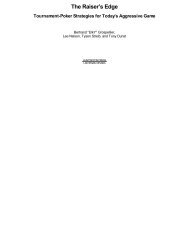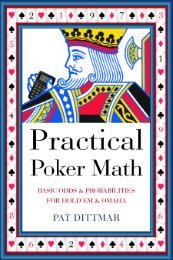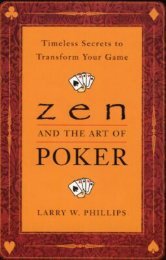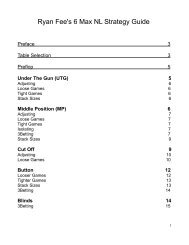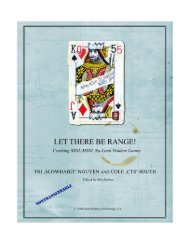Create successful ePaper yourself
Turn your PDF publications into a flip-book with our unique Google optimized e-Paper software.
140<br />
decision may be a totally different decision. Referring to<br />
balanced play by saying "optimal poker" may easily be taken to<br />
mean that playing a balanced strategy is superior to playing an<br />
exploitive play. This isn't always the case. Taking a look at a<br />
maximally exploitive strategy will get us closer to thinking<br />
properly about playing balanced poker.<br />
Playing a maximally exploitive strategy has us making drastic<br />
changes in our play. Here’s an example to show this in action.<br />
Let’s say we get to a river, and our opponent bets the pot. We<br />
have a bluff catcher, and we’re left with a decision of whether or<br />
not to call. When someone bets the pot, we need to be good<br />
better than 33% of the time in order to make a +EV call. This<br />
means our opponent must be bluffing more than 33% of the time<br />
in order for us to have a +EV call. Now, let’s say we know our<br />
opponent has only bluffs. How often do we call? We obviously<br />
call 100% of the time. Let’s say we know our opponent is never<br />
bluffing. How often do we call? We obviously never call.<br />
However, what is the maximally exploitive play if our opponent<br />
bluffs 50% of the time? Some people feel that we should now<br />
call a bit more frequently; however, this would not be the<br />
maximally exploitive strategy. The maximally exploitive<br />
strategy is to call 100% of the time. When playing a maximally<br />
exploitive strategy, we call 100% of the time whether the<br />
opponent is bluffing 34% of the time or 100% of the time.<br />
Anytime his bluffing frequency is over 33%, we call 100%.<br />
Each time we fold a bluff catcher, we lose some expectation<br />
value. The same is true if the opponent were only bluffing 25%<br />
of the time. Some may feel we should now fold sometimes.<br />
However, this is not maximally exploiting the weakness in our<br />
opponent’s strategy. The maximally exploitive decision is to<br />
always fold. This is true whether he’s bluffing 32% of the time<br />
or never bluffing. Each time we call with a bluff catcher, we<br />
lose some EV. So, you see that a maximally exploitive strategy





